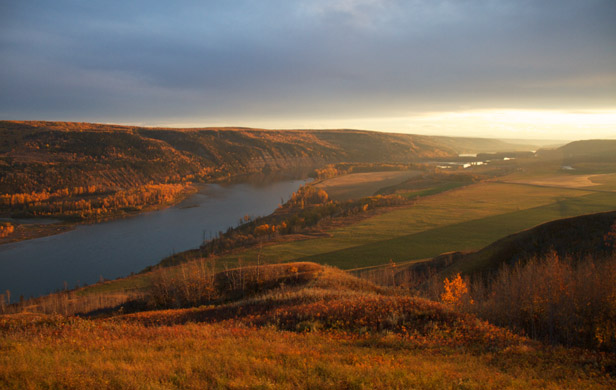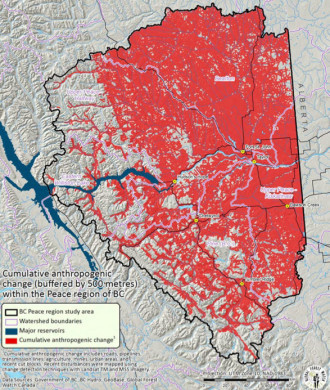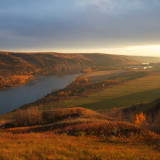
Keeping the Peace Valley’s farmland and ecosystems intact would be worth $7.9 billion to $8.6 billion a year, says a new study from the David Suzuki Foundation.
The region, in northeast BC, is under threat from the proposed Site C Dam – which would flood or disturb over 30,000 acres of prime agricultural land – along with natural gas fracking operations, logging, mining and other forms of industrialization. The study is a follow-up to an earlier report which analyzed the area via satellite imagery, determining that some 67% of its landmass had been impacted by multiple layers of industrial activity.
Region’s ecosystems provide many valuable services

This latest report, which involved 3 years of intense data collection, analysis and review, tabulates the economic value of preserving what remains of the valley’s natural values. “These ecosystems play a critical role in providing clean air, clean water, habitat for wildlife and many other ecological benefits that sustain the health and well-being of local residents, and contribute to the cultural and traditional ways of First Nations,” says DSF.
The services provided by the 5.6 million-hectare region’s diverse ecosystems include “water supply, air filtration, flood and erosion control, habitat for wildlife and agricultural pollinators, carbon storage and other benefits.”
“We’re concerned because the strain on the Peace River Watershed’s farmland and natural ecosystems will only increase with the B.C. government’s plan for increased oil and gas development, including liquefied natural gas, as well as large infrastructure projects such as the proposed Site C Dam,” says the Foundation’s Dr. Faisal Moola.
Farmland could feed a million people
At the environmental assessment hearings into the $8 Billion proposed Site C Dam, expert agrologists Wendy Holm and Evelyn Wolterson told the Joint Review Panel that the land in the proposed flood and impact zone could feed a million people. This is due to the extraordinary soils and climate conditions of the valley, Wolterson explained.
[quote]These are all elements of this valley that make it absolutely unique…not only in the region but in all of British Columbia, and perhaps Western Canada…It is our opinion that the public interest is better served [by] agriculture and other uses for this valley, rather than a hundred years of power production.[/quote]
$7 Billion/year in carbon sequestration
The Suzuki report also calculates the value of the region’s forests, grasslands and wetlands in terms of carbon storage, pegged at $6.7 billion to $7.4 billion a year, with other ecosystem services contributing $1.2 billion a year.
Says Moola, “…our study shows that remaining farmland and natural areas have an incredible ability to generate natural wealth.”
[quote]We’re concerned because the strain on the Peace River Watershed’s farmland and natural ecosystems will only increase with the B.C. government’s plan for increased oil and gas development, including liquefied natural gas, as well as large infrastructure projects such as the proposed Site C Dam.[/quote]
Site C review panel worried about cumulative impacts
While the Joint Review Panel opted not to render a definitive verdict on the dam in its report, released in May, it did echo DSF’s concerns about the cumulative effects of multiple projects in the region, compounding the dam’s impacts. “Whether the Project proceeds or not, there is a need for a government-led regional environmental assessment including a baseline study and the establishment of environmental thresholds for use in evaluating the effects of multiple, projects,” the Panel stated.
First Nations back report
Chief Roland Wilson of West Moberly First Nations echoed the Suzuki Foundation report, noting that his people “have been blessed with forests, rushing rivers and rolling grasslands that have sustained our communities for thousands of years. However, the cumulative effects of industrial development in our territories have been massive and can’t be mitigated. They’ve had an enormous impact on our treaty rights as First Nations people.”
According to Moola, various aboriginal representatives helped guide the Suzuki report with their traditional knowledge of the area. “First Nations helped decide the study area, identify data sources, and review the work – including ensuring that we accurately reflected the place names, and other references to their Dane_Zaa culture”.
Many of these aboriginal voices are represented verbatim in the 2013 DSF-published report, Passages for the Peace, which includes interviews with elders, hunters, artists and other community members describing the role the land plays in their lives and the value of natural capital in their culture and economy.
Many Treaty 8 First Nations throughout the region have opposed the dam, joining forces with local farmers and landowners.
Site C decision expected in September
The federal Cabinet is expected to render a decision on the dam in September. Says Moola, “We hope this report encourages discussion about how natural areas and farmland in B.C.’s irreplaceable Peace Region are valued — and undervalued — when decisions are made that could destroy the region’s natural wealth.”
[signoff3]


Getting this message through to a government that has already had its mind made up by their corporate handlers and benefactors who intend to see this dam built on our backs seems like an impossible task.
Certainly using common sense and public good is never near the front of their minds or their agendas anymore than us expecting common sense pleading on our part to have any affect on their behaviour either.
This dam will not be built but it will not be stopped without a physical and widely publicized confrontation on the front lines both in Victoria and in the Peace.
Yes, it is an uphill battle, Ron.
At the end of the day, the enormous cost to taxpayers, already buried in debt and facing the strain on our education and health care systems as a result, is likely the biggest Achilles’ heel for the dam.
This is a government that has gone chronically over-budget with its capital projects, as I detailed in a recent piece, which should be of real concern given the massive price tage on the dam to begin with. If we factor in their usual premium of double the estimated cost, plus years of financing costs, this is probably a $25 Billion boondoggle for taxpayers.
https://commonsensecanadian.ca/liberals-big-projects-often-double-cost-site-c-dam-different/
Juxtapose that with the value that will be lost from farmland and the sort of ecosystem services this DSF report goes into, and it looks like a terrible deal for the public, from this supposedly fiscally shrewd government. With heavy-hitters in the business community speaking out against it, there is cause for hope that the financial foundation supporting the dam will collapse.
https://commonsensecanadian.ca/REPORTED_ELSEWHERE-detail/site-c-dam-hike-power-bills-drive-mills-mines-business/
Despite all the other compelling reasons for not building the dam, that’s likely the one that poses the biggest threat.
But there is also the likelihood of legal action from First Nations and, as you say, the potential for civil disobedience…